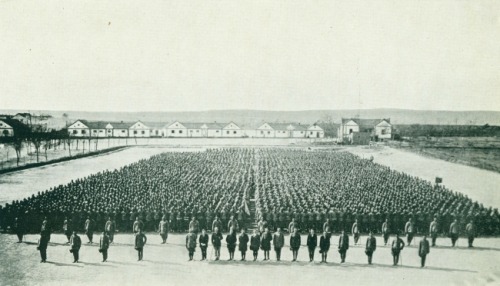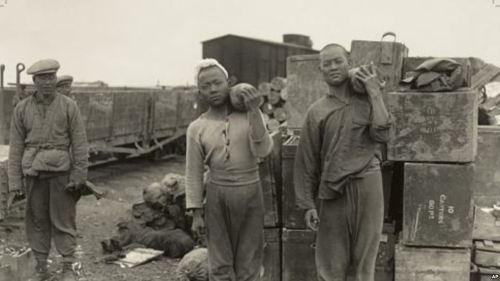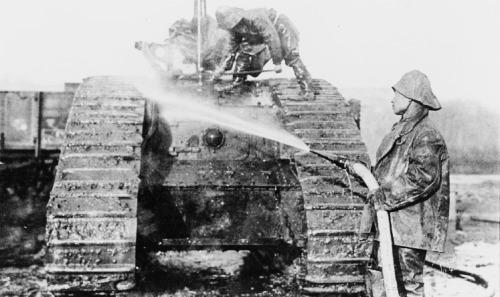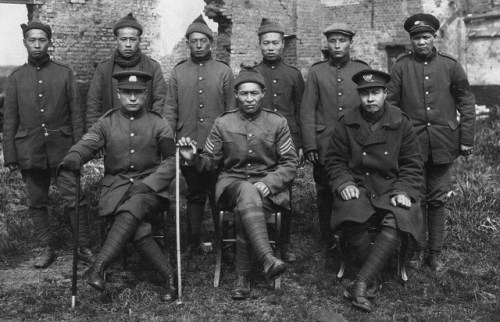peashooter85:The Chinese Labor Corps of World War I,“While the sun does not set on the British Empir
peashooter85:The Chinese Labor Corps of World War I,“While the sun does not set on the British Empire, neither does it set on Chinese workers abroad.”—Chen DuxiuDuring World War I one major problem faced by both sides of the conflict was a shortage of labor, as most working age men either volunteered or were drafted into the military. Many labor roles would be taken up by women. Many more would be taken up by foreign laborers hired or conscripted from different countries. During World War I, China was in the throws of a bloody and complex civil war. The government of the Manchu Emperor had been overthrown by a new Nationalist Government, however the country quickly collapsed into a series of realms and factions controlled by warlords of the former Imperial Army. As a result of the war, China faced hard economic times, and many Chinese looked abroad for opportunities. In 1916, the French and British Government contracted 50,000 Chinese to serve as laborers in the Western Front. Over the next two years, another 100,000 would eventually be hired, 100,000 of which would serve under the British, 40,000 under the French, and 10,000 under the Americans. They were used for a wide variety of purposes, including unloading equipment at docks, digging trenches and building fortifications, working in munitions factories, repairing tanks, transporting supplies, cleaning up battlefields after a large battle, and other rear echelon duties. While the vast majority of Chinese Labor Corps were workers, a few hundred were students, contracted to work with the British and French Army as translators.Life as a Chinese Labor Corps member was not easy. Living standards were very low, and workers were issued the cheapest clothing, the simplest food, and were paid a mere few francs a day. In order to travel to Europe, the workers were packed onto crowded transports, then packed onto crowded cattle cars once they arrived. Living quarters and barracks were also crowded and very spartan. Most importantly, life as a Chinese Labor Corps workers was very dangerous. While they were non-combatants, it was not uncommon for the Chinese to get caught in the middle of fire fights and artillery barrages. Such was the case for First Class Ganger Liu Dien Chen who was awarded the British Meritorious Service Medal for bravery when his work crew came under artillery fire while repairing tanks. Five Chinese would be awarded the Meritorious Service Medal, and all would be awarded the British War Medal at the end of the war. In addition to pitched combat there were other hazards. Chinese laborers were often used to clean up battlefields after combat had concluded. This involved burying trenches, recovering corpses, and removing damaged and destroyed equipment. Accidents involving un-exploded bombs and artillery shells were common. When the Great Flu Pandemic spread across the world in 1917-1918, around 2,000 Chinese laborers would fall victim. Altogether, 20,000 would die of various causes, their bodies interred in 40 military graveyards across France and Belgium.After the war ended, most Chinese workers remained in France, contracted by the French Government to conduct rebuilding efforts. The first large groups were transported back to China in 1919, the last in 1920. All Chinese Labor Corps members were awarded medals and pay bonuses, while those who were injured, disabled, or who had family members killed were awarded government pensions. Around 5,000 chose to stay in France, in particular the Parisian Region, becoming one of the first large Chinese communities in Europe. In addition to the the Chinese Labor Corps in the Western Front, a similar program was conducted by the Russian Government on the Eastern Front, recruiting around 200,000 - 500,000 workers. -- source link
Tumblr Blog : peashooter85.tumblr.com



